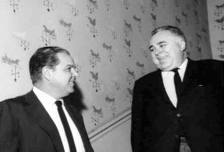By mid-1961, there had been multiple attempts to adapt Ian Fleming’s James Bond to other media. A 1954 CBS adaptation of Casino Royale had become reality and was mostly forgotten. No film versions had yet gone before the cameras. That was about to change as American Albert R. Broccoli and Canadian Harry Saltzman agreed to team up. It’d be an eventful, and sometimes stormy, 14 years.
Each had something the other wanted: Saltzman had secured a six-month option on Fleming’s novels other than Casino Royale (and a court settlement would take the 1961-published Thunderball out of that package). Broccoli had studio connections that Saltzman lacked. Broccoli wanted to buy the option from Saltzman, but the latter wanted to go into business with Broccoli.
Saltzman, by multiple accounts, provided a constant flow of ideas. The quality, reportedly, was erratic but when they were good, they were brilliant. (Let’s have Bond “killed” at the start of From Russia With Love.) He could be volatile, almost killing off what would be two of the most popular title songs in the 007 series (Goldfinger and Diamonds Are Forever). Composer John Barry bemoaned in a 2006 U.K. television special that, “I could never deal with Harry and didn’t.”
Broccoli, by these accounts, was the steadier, more patient of the duo. He had wanted to do Bond for years before meeting Saltzman and was mostly content with 007, a large endeavor of its own. Saltzman, meanwhile, would launch a series based on Len Deighton’s spy novels and pursue other non-Bond projects.
Eventually, the producers grew apart, with Live And Let Die primarily a Saltzman production (although there are shots of Broccoli visiting locations and sets) while The Man With the Golden Gun was primarily overseen by Broccoli. The partnership would end when Saltzman, in severe financial trouble, sold his half of the franchise to United Artists, the studio that released the 007 films.
During work on 1962’s Dr. No, the producers managed to find a collaborative rhythm. James Bond probably would have come to the screen, but likely not in exactly the same form had Broccoli and Saltzman not joined forces.
For their work on Dr. No, the first 007 film, Broccoli and Saltzman received a producer’s fee of $80,000 and 50 percent of the profits, according to the 1998 book Adrian Turner on Goldfinger. The film debuted on Oct. 5, 1962, in the U.K., reaching other countries the following year.
If you CLICK HERE, you can view a 1965 interview the CBC did with Broccoli and Saltzman. At this point, Thunderball was about to be released.
Around the 14:00 mark, Saltzman has to take a call regarding a censorship issue with one of his non-007 movies. At the end, Saltzman works in a plug for his Harry Palmer films. You can view Broccoli’s expressions and draw your own conclusions about what the producer may have been thinking.
NEXT: The $40,000 man
Filed under: James Bond Films | Tagged: Adrian Turner on Goldfinger, Albert R. Broccoli, Dr. No, Dr. No's 50th anniversary, Harry Saltzman, James Bond Films, Len Deighton, Live and Let Die, The Man with the Golden Gun, United Artists |



[…] proved once and for all the judgment of producers Albert R. Broccoli and Harry Saltzman — the odd couple forced by circumstances to join forces — that Bond had major commercial potential. The likes […]
[…] 1963 007 outing proved once and for all the judgment of Broccoli and Saltzman — the odd couple forced by circumstances to join forces — that Bond had major commercial potential. The likes […]
[…] 1963 007 outing proved once and for all the judgment of Broccoli and Saltzman — the odd couple forced by circumstances to join forces — that Bond had major commercial potential. The likes […]